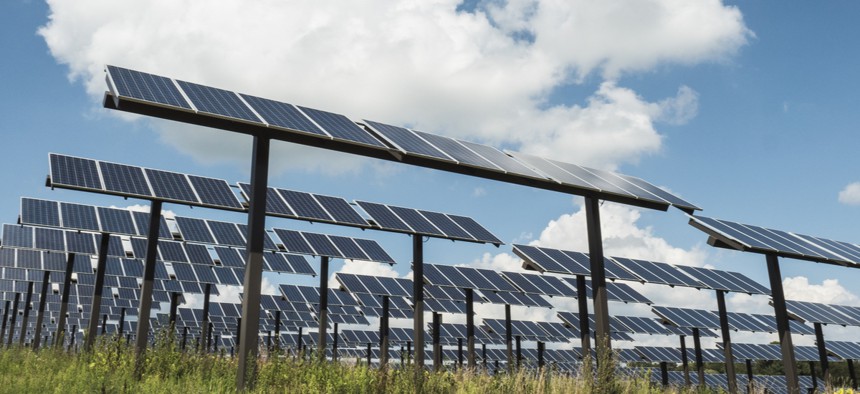How Hundreds of Cities Have Simplified Solar

Solar was relatively easy to obtain in Stevens Point, Wisconsin, but the city did little to promote the program, so most people weren't aware it was an option. Shutterstock
More than 300 municipalities have received designations from SolSmart, a national program that helps streamline permitting and zoning processes to make solar easier to obtain for residents and businesses.
For years, it had been relatively easy for residents and businesses in Stevens Point, Wisconsin, to install solar projects. The zoning and permitting process was straightforward, with few barriers in place once people expressed interest. But the city did little to promote it, so most people weren’t aware it was an option.
“Our process didn’t necessarily prevent people from doing it. It wasn’t heavily regulated, but we didn’t have a platform that made it easily attainable,” said Kyle Kearns, associate planner and zoning administrator for the central Wisconsin city. “We were turning around permits and doing inspections the same day, but we didn’t identify that anywhere. It wasn’t clearly stated.”
In retrospect, Kearns said, it was a problem with an obvious solution. But like in many cities, staffers in Stevens Point were balancing their day-to-day workloads with multiple long-term projects. Identifying and fixing the shortcomings in the solar program was a desire, not a necessity, and would require time and resources that the city didn’t have.
And then SolSmart came calling.
SolSmart, a product of the Solar Foundation and the International City/County Management Association, is a national designation program that recognizes municipalities and organizations that make it “faster, easier and more affordable to go solar.” Cities that choose to participate in the federally funded program work with experts, provided at no cost, who help streamline permitting and zoning processes and identify areas for fee reduction, among other improvements. At the end, depending on the changes they make, participating cities are issued SolSmart designations of bronze, silver or gold.
To date, more than 300 municipalities have gone through the program, a process that starts with a city or town creating what’s known as a “solar statement,” said Theresa Perry, program director for the Solar Foundation.
“It’s a written commitment, on their letterhead, that they are interested in working with us toward one of the designations,” she said. “Writing that letter hopefully establishes that they are committing their resources to doing this. Then they’ll be assigned a technical assistance director that will work locally with the city to walk them through the designation process and provide any help they might need.”
In Stevens Point, that advisor was Eric Rehm, solar finance manager for the Midwest Renewable Energy Association, a regional nonprofit that promotes sustainable practices. Rehm reached out to the city to gauge their interest, then helped staff, including Kearns, identify their goals in improving and promoting their solar program.
“We defined the things that already had been done and the things that the community was interested in pursuing,” Rehm said. “Once that work plan was generally laid out, then it was a process of working with him and providing training.”
Training typically includes a review of zoning practices and identifying barriers to permitting, along with examining the language of ordinances and tweaking things to be more customer-friendly. In Stevens Point, the program infrastructure was relatively solid, so SolSmart’s work there consisted mostly of crafting a strategy to communicate and promote the existing process.
“That’s often the case, and the program accounts for that,” Rehm said. “Sometimes it’s training, and in other cases it’s using toolkits the organization created to get a community up on best practices, or crafting generalized language for ordinances.”
Most notably, Stevens Point had never specifically identified solar in its permitting or zoning codes. The city also did not have a website to explain or promote the program, so prospective solar clients had no way to find information about it anywhere online.
“The biggest goal for us was making sure that people knew solar was available here, so we made a website, made documents, and then made a lot of edits to both of those,” Kearns said. “We were already doing a lot of the things required to meet the gold designation. It was just a matter of documenting those and creating the educational outreach documents to show that we were doing them.”
Rehm helped guide that process, outlining a plan for the work and checking in with administrators several times per month. The end result included changes to zoning and permitting codes that specifically identify solar projects, along with a polished website explaining the city’s solar program. That type of clear communication is a key focus of the SolSmart program, Rehm said, because any vagueness in the process can be a major deterrent for both residential and commercial development.
“The absence of highlighting solar specifically in ordinances—that opaqueness creates an uncertainty in the marketplace,” he said. “It’s important to get that out onto the website so that a homeowner, a business, or a developer has a clear understanding that solar can be done, and what the permit costs are.”
The designation process began in June and took about four months to complete. Since then, Stevens Point hasn’t noted a huge uptick in demand for solar permits. But that wasn’t necessarily the goal, Kearns said.
“We just knew, when we started, that we were far from achieving that gold standard,” he said. “We probably would have realized eventually that we weren’t identifying a platform for our citizens to easily obtain solar, and we may have invested the time to do it ourselves, but the downside there is that we may not have had assistance available to us. That assistance was key for us.”
Kate Elizabeth Queram is a Staff Correspondent for Route Fifty and is based in Washington, D.C.
NEXT STORY: Urban and Suburban Lifestyles Are More Similar Than You’d Think





